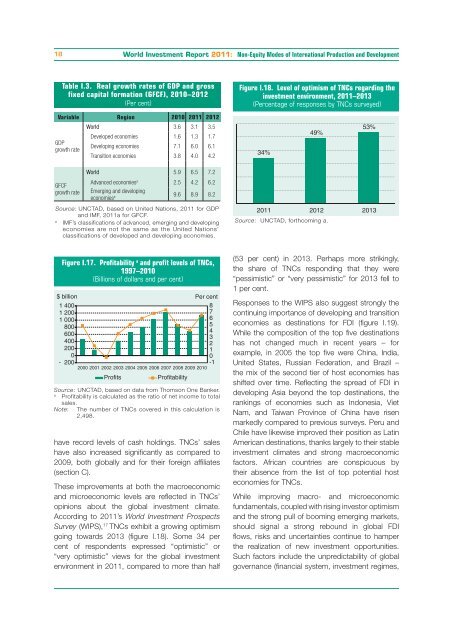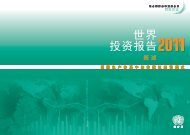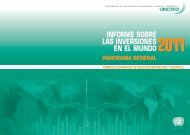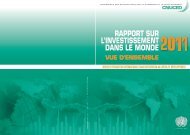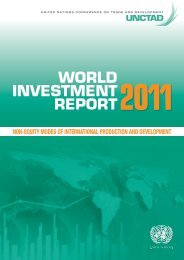CHAPTER I Global Investment Trends
CHAPTER I Global Investment Trends
CHAPTER I Global Investment Trends
Create successful ePaper yourself
Turn your PDF publications into a flip-book with our unique Google optimized e-Paper software.
18<br />
World <strong>Investment</strong> Report 2011: Non-Equity Modes of International Production and Development<br />
Table I.3. Real growth rates of GDP and gross<br />
fixed capital formation (GFCF), 2010–2012<br />
(Per cent)<br />
Variable Region 2010 2011 2012<br />
GDP<br />
growth rate<br />
GFCF<br />
growth rate<br />
World 3.6 3.1 3.5<br />
Developed economies 1.6 1.3 1.7<br />
Developing economies 7.1 6.0 6.1<br />
Transition economies 3.8 4.0 4.2<br />
World 5.9 6.5 7.2<br />
Advanced economies a 2.5 4.2 6.2<br />
Emerging and developing<br />
economies a 9.6 8.9 8.2<br />
Source: UNCTAD, based on United Nations, 2011 for GDP<br />
and IMF, 2011a for GFCF.<br />
a IMF’s classifications of advanced, emerging and developing<br />
economies are not the same as the United Nations’<br />
classifications of developed and developing economies.<br />
Figure I.17. Profitability a and profit levels of TNCs,<br />
1997–2010<br />
(Billions of dollars and per cent)<br />
$ billion<br />
Per cent<br />
1 400<br />
8<br />
1 200<br />
1 000<br />
800<br />
600<br />
400<br />
200<br />
0<br />
7<br />
6<br />
5<br />
4<br />
3<br />
2<br />
1<br />
0<br />
- 200<br />
-1<br />
2000 2001 2002 2003 2004 2005 2006 2007 2008 2009 2010<br />
Profits Profitability<br />
Source: UNCTAD, based on data from Thomson One Banker.<br />
a Profitability is calculated as the ratio of net income to total<br />
sales.<br />
Note: The number of TNCs covered in this calculation is<br />
2,498.<br />
have record levels of cash holdings. TNCs’ sales<br />
have also increased significantly as compared to<br />
2009, both globally and for their foreign affiliates<br />
(section C).<br />
These improvements at both the macroeconomic<br />
and microeconomic levels are reflected in TNCs’<br />
opinions about the global investment climate.<br />
According to 2011’s World <strong>Investment</strong> Prospects<br />
Survey (WIPS), 17 TNCs exhibit a growing optimism<br />
going towards 2013 (figure I.18). Some 34 per<br />
cent of respondents expressed “optimistic” or<br />
“very optimistic” views for the global investment<br />
environment in 2011, compared to more than half<br />
Figure I.18. Level of optimism of TNCs regarding the<br />
investment environment, 2011–2013<br />
(Percentage of responses by TNCs surveyed)<br />
34%<br />
49%<br />
Source: UNCTAD, forthcoming a.<br />
53%<br />
2011 2012 2013<br />
(53 per cent) in 2013. Perhaps more strikingly,<br />
the share of TNCs responding that they were<br />
“pessimistic” or “very pessimistic” for 2013 fell to<br />
1 per cent.<br />
Responses to the WIPS also suggest strongly the<br />
continuing importance of developing and transition<br />
economies as destinations for FDI (figure I.19).<br />
While the composition of the top five destinations<br />
has not changed much in recent years – for<br />
example, in 2005 the top five were China, India,<br />
United States, Russian Federation, and Brazil –<br />
the mix of the second tier of host economies has<br />
shifted over time. Reflecting the spread of FDI in<br />
developing Asia beyond the top destinations, the<br />
rankings of economies such as Indonesia, Viet<br />
Nam, and Taiwan Province of China have risen<br />
markedly compared to previous surveys. Peru and<br />
Chile have likewise improved their position as Latin<br />
American destinations, thanks largely to their stable<br />
investment climates and strong macroeconomic<br />
factors. African countries are conspicuous by<br />
their absence from the list of top potential host<br />
economies for TNCs.<br />
While improving macro- and microeconomic<br />
fundamentals, coupled with rising investor optimism<br />
and the strong pull of booming emerging markets,<br />
should signal a strong rebound in global FDI<br />
flows, risks and uncertainties continue to hamper<br />
the realization of new investment opportunities.<br />
Such factors include the unpredictability of global<br />
governance (financial system, investment regimes,


